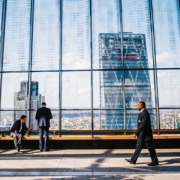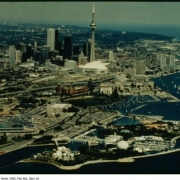Quick Facts about Green Retrofitting
Contributor: Mahtot Gebresselassie, ICL Project Management Solutions
Green retrofits are becoming more popular than new green construction. They are a less risky investment because there is no cost to build the main components of the building. Green retrofits are also more efficient in that they use minimal to no new natural resources to construct the components of the building.
Weather Beacon at Canada Life, at 330 University Avenue, Toronto. The green upgrade from incandescent light to LED (light emitting diode) is to reduce energy consumption. Click here for photo credit: Left, Right
This article explores quick facts that will help you better acquaint yourself with green retrofitting. We recommend that you review the table below to appreciate fully the benefits of green retrofitting by understanding buildings, their consumption of resources, and their effects on humans and their surroundings.
Click here for source.
What are some of the green aspects of buildings? Physical building components, design of the buildings, systems of operation, and interior spaces.
What are some specific examples of green-ness? Proximity to transit infrastructure; building materials that have good insulation and low emission of harmful substances; alternative energy sources; double plumbing to use rain water or grey water; roof gardens; and interior garden walls. 
Retrofitted interior of Adamson Associates Architects Toronto Office, 401 Wellington Street East. LEED EB: O& M certified. Click here for photo credit.
What is green retrofitting? Remodeling or upgrading partially or fully occupied building interiors and exteriors with green elements and systems without interrupting the daily routines of the occupants. Green retrofitting can be done piecemeal, i.e. small-size green update at a time. However, comprehensive retrofits, though more expensive initially, are more effective over the long term as the coordination of green elements and systems results in their increased combined benefits.
What are the benefits of green retrofitting? Lower cost of operating buildings; improved quality of spaces, for example, through natural lighting; gain in floor area (in some instances) due to the replacement of bulky mechanical equipment and building materials with thin variety; improved corporate image in social responsibility; tax credits and government incentives; lessened impact on infrastructure; efficient use of natural resources; and lessened ecological impact.
Are new buildings greener than retrofitted? No. In fact, using existing buildings is more resource-efficient than new green construction; it doesn’t use new resources for the building components and the construction process. In addition, green retrofits are a safer investment than new green construction as there is no cost for the construction of the main components of buildings.
 Before retrofitting After retrofitting
Before retrofitting After retrofitting
First Canadian Place, 100 King Street West, Toronto, ON M5X 1A9, Retrofitted building, LEED-EB: O&M. The marble cladding was replaced with green cladding. Click here for photo credit. Left, Right
What are the disadvantages/challenges of green retrofitting? The initial cost of green retrofitting or building a new green building maybe high; there is an uncertainty factor in terms of what you might encounter inside an existing building (inside walls, roofs); there is no guarantee that building retrofits increase property value; industry professionals are not very well versed in greet retrofitting; the benefit of retrofitted buildings is in reducing operating costs once the relatively expensive retrofitting is done; developers need proof and there doesn’t seem to be a data a lot of data to support the benefits of green retrofits/construction; and potential liability issues could arise in a case of green retrofits not saving on operating costs.
Can retrofitted buildings Certified? There is a specific certification system, LEED EB: O&M, which means LEED for Existing Buildings: Operation and Maintenance.
McMichael Canadian Art Centre, 10365 Islington Ave, Kleinburg, Ontario. LEED EB: O&M certified. Click here for photo credit.
This article was published originally on ICL Project Management Solutions blog.”
Sources
http://www.deloitte.com/assets/Dcom
UnitedStates/Local%20Assets/Documents/us_re_Dollars_Sense_Retrofits_190608_.pdf
http://www.westerninvestor.com/index.php/news/55-features/918-deep-green-retrofits
http://www.nytimes.com/2010/06/02/realestate/commercial/02deutsche.html?_r=0
https://www.esbnyc.com/documents/sustainability/uli_building_retro_fits.pdf
http://www.dcnonl.com/article/id48227/–expansion-of-ldquogreenrdquo-retrofits-expected
http://www.cagbc.org/leed/projectprofile_EN.aspx
http://www.calrecycle.ca.gov/greenbuilding/basics.htm
http://greenliving.about.com/od/architecturedesign/tp/green_buildings.htm
http://www.epa.gov/greenbuilding/pubs/faqs.htm#1
http://www.newswire.ca/en/story/1208381/iconic-canada-life-weather-beacon-goes-green











